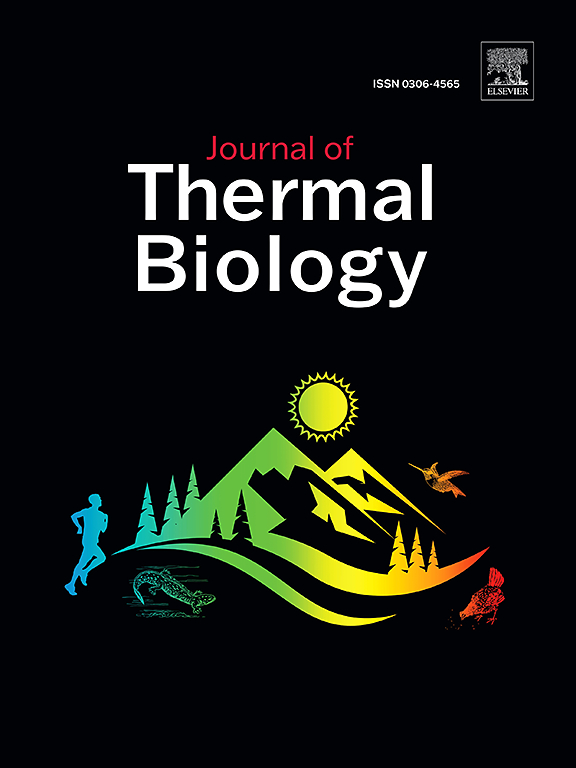Empirical evidence for the extent of spatial and temporal thermal variation on sea turtle nesting beaches
IF 2.9
2区 生物学
Q2 BIOLOGY
引用次数: 0
Abstract
Recording sand temperatures has become routine at many sea turtle nesting sites across the world given the impacts of incubation temperatures on hatchling sex ratios. However, the extent of thermal variability found at a nesting site has previously received little attention. Here we examine empirical sand temperature records across five atolls extending 250 km in the Chagos archipelago, Indian Ocean, between October 2012 and July 2023 and quantify the extent of spatial and temporal thermal variability. Our results suggest that sand temperatures at our study site vary seasonally and inter-annually, between beaches in the archipelago, and within beaches in different nesting habitats. The biggest drivers of thermal variability were seasonal and inter-annual differences, which modulated sand temperatures by up to 3.00 °C and 1.03 °C, respectively. Intra-beach and inter-beach variability further modulated temperatures by up to 0.56 °C and 0.85 °C, respectively. In addition, mean monthly sand temperatures were relatively low, suggesting that hatchling sex ratios are fairly balanced. The wide range of sand temperatures recorded at this nesting site suggests that it is likely both male-biased and female-biased clutches are produced during the nesting season. Quantifying thermal variability from a long-term sand temperature time series offers valuable insight into a population with temperature-dependent sex determination and, when possible, should be considered when modelling temperature impacts on hatchling sex ratios.
海龟筑巢海滩时空热变化程度的经验证据。
鉴于孵化温度对幼龟性别比的影响,在全球许多海龟筑巢地记录沙温已成为例行工作。然而,筑巢地点的热变异程度以前很少受到关注。在此,我们研究了 2012 年 10 月至 2023 年 7 月期间印度洋查戈斯群岛绵延 250 公里的五个环礁的沙温实证记录,并量化了空间和时间热变异的程度。我们的研究结果表明,我们研究地点的沙温存在季节性和年际性差异,群岛内不同海滩之间以及不同筑巢栖息地海滩内部的沙温也存在差异。热变异的最大驱动因素是季节性差异和年际差异,它们对沙温的影响分别高达3.00 °C和1.03 °C。海湾内和海湾间的温度变化对温度的调节作用分别高达 0.56 ℃ 和 0.85 ℃。此外,月平均沙温相对较低,表明幼体性别比例相当均衡。在该筑巢地点记录到的沙温范围很广,这表明在筑巢季节很可能会同时产生雄性偏向和雌性偏向的卵。从长期的沙温时间序列中量化热变异,可对性别决定依赖于温度的种群提供有价值的见解,在可能的情况下,在模拟温度对孵化雏鸟性别比的影响时应加以考虑。
本文章由计算机程序翻译,如有差异,请以英文原文为准。
求助全文
约1分钟内获得全文
求助全文
来源期刊

Journal of thermal biology
生物-动物学
CiteScore
5.30
自引率
7.40%
发文量
196
审稿时长
14.5 weeks
期刊介绍:
The Journal of Thermal Biology publishes articles that advance our knowledge on the ways and mechanisms through which temperature affects man and animals. This includes studies of their responses to these effects and on the ecological consequences. Directly relevant to this theme are:
• The mechanisms of thermal limitation, heat and cold injury, and the resistance of organisms to extremes of temperature
• The mechanisms involved in acclimation, acclimatization and evolutionary adaptation to temperature
• Mechanisms underlying the patterns of hibernation, torpor, dormancy, aestivation and diapause
• Effects of temperature on reproduction and development, growth, ageing and life-span
• Studies on modelling heat transfer between organisms and their environment
• The contributions of temperature to effects of climate change on animal species and man
• Studies of conservation biology and physiology related to temperature
• Behavioural and physiological regulation of body temperature including its pathophysiology and fever
• Medical applications of hypo- and hyperthermia
Article types:
• Original articles
• Review articles
 求助内容:
求助内容: 应助结果提醒方式:
应助结果提醒方式:


